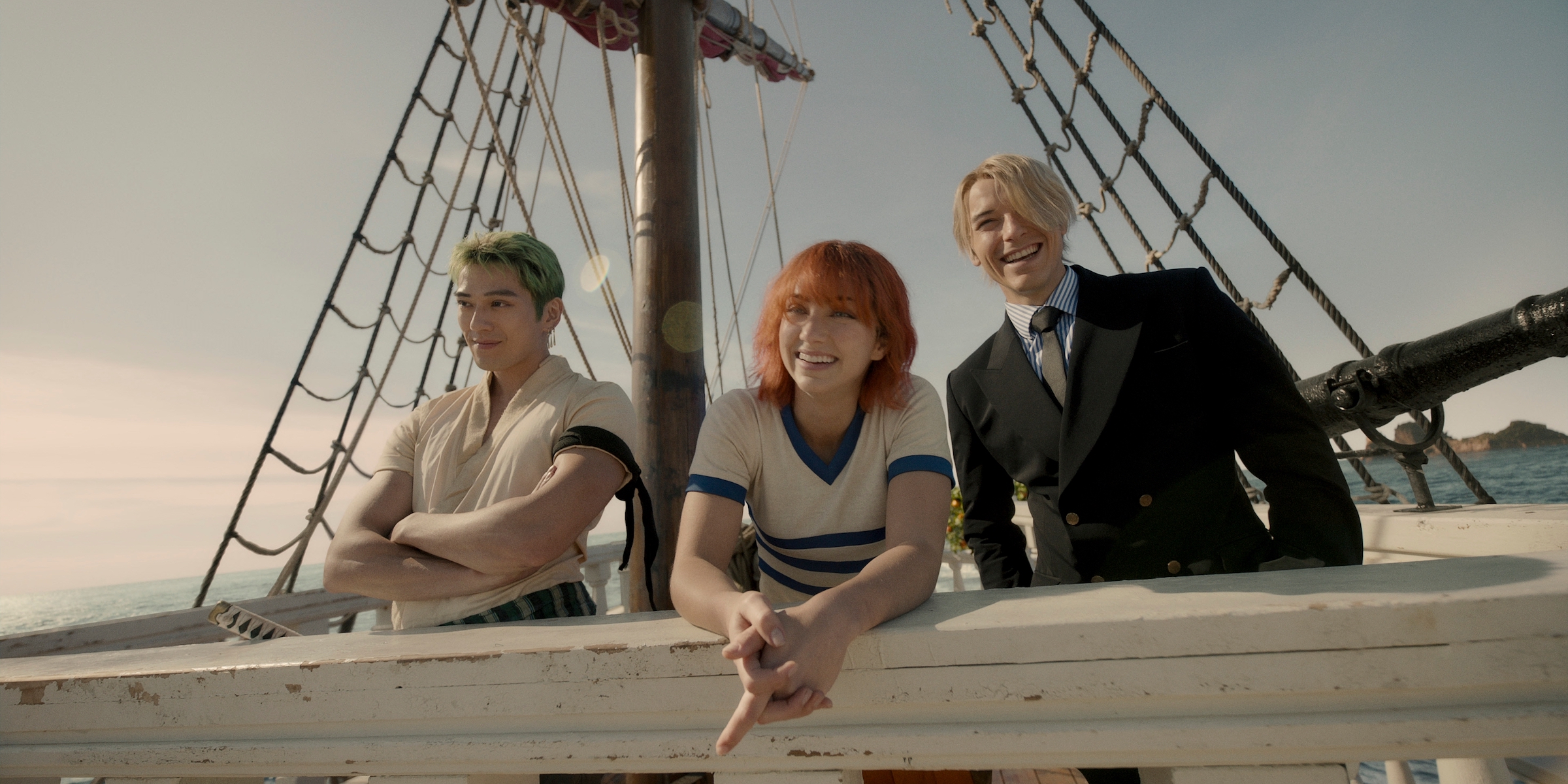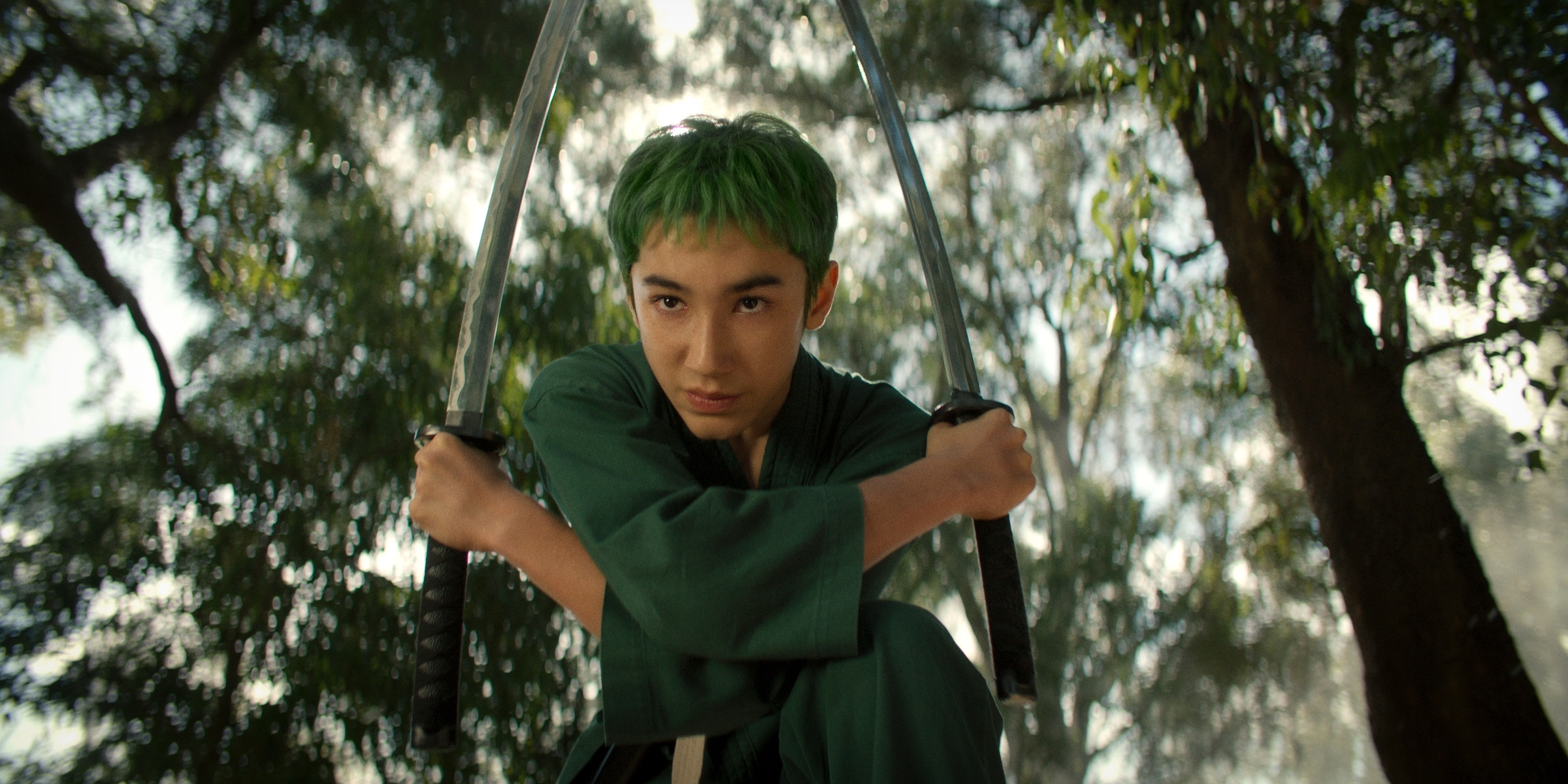A manga series can’t become Japan’s highest selling title in history without building a truly global fanbase along the way. And that’s precisely what Eiichiro Oda’s One Piece has done in the 26 years it has been serialized. Fans—old and young, Japanese and international—have grown attached to its 106 tankōbon volumes and subsequent anime series, which first aired in 1999 and has racked up over 1,070 episodes since. Now, as Oda prepares for his revered illustrative series to approach its final saga, Netflix is steering the fantastical world of the Straw Hat Pirates to new shores, with an eight-part live action series arriving on the streaming platform Aug. 31.
The series, produced with Shueisha and Tomorrow Studios, depicts the East Blue arc of One Piece. East Blue refers to the part of the ocean where we find protagonist Monkey D. Luffy (Iñaki Godoy), a fresh-faced and optimistic adventurer telling anyone who will listen that he will one day become king of the pirates. Luffy is on a quest to find the so-called One Piece, an elusive treasure belonging to the legendary deceased pirate Gol D. Roger. The treasure is hidden somewhere along the perilous Grand Line route, that stretches across the globe. Luffy’s secret weapon—aside from his infectious positivity—is that his body has stretchy, rubber-like properties as the result of a devil fruit called the Gum-Gum fruit that he consumed as a child.
While Luffy starts his journey alone, he accumulates impressive crewmates who have their own dreams and agendas. Viewers meet Roronoa Zoro (Mackenyu), a pirate hunter and master of three-sword combat; Nami (Emily Rudd), a resourceful thief and cartographer; Usopp (Jacob Romero Gibson), a well intentioned yet cowardly dreamer; and Sanji (Taz Skylar), an innovative chef. Inspired by Luffy and his loyalty, the Straw Hat Pirates crew is born and subsequent friendships form between the young talents. Together, the group must secure their perfect pirate ship, outmaneuver unexpected antagonists such as Buggy the depraved clown, and avoid the marines (seaborne law enforcers of the One Piece universe.)

As the highly anticipated series arrives on Netflix, here’s what to know about the show.
What do One Piece fans expect?
By August 2022, One Piece had sold over 516 million copies in 61 countries; the series comes with a built-in audience and Netflix knows this. The streaming giant hosted 10 worldwide fan screenings and events in cities such as Los Angeles, Paris, Jakarta, Milan, and Tokyo, ahead of its premiere.
“The cultural reputation of One Piece is very solid. It is the manga gold standard by which other popular long running works are judged,” Nicole Coolidge Rousmaniere, a professor of Japanese Arts and Cultures at the University of East Anglia, in the U.K, tells TIME.
Additionally, she says, it has captured “the zeitgeist of growing up, finding your tribe and being accepted for who you are.” Rousmaniere says the show’s burgeoning fanbase is a result of Oda's innovative storytelling and his willingness to include readers in the conception process.
But with this immaculate reputation comes pressure for writers and showrunners Matt Owens and Steven Maeda, as viewers eagerly wait to see if the live action series does justice to the rich and unfolding source material fans hold so dearly. Oda—known to value his privacy—even wrote a letter in July urging fans who were disappointed by teasers to view the show as the labor of love that it was for the creators. “After the launch, I’m sure I’ll hear about some people pointing out how this character is missing or that scene is omitted, or this bit is different from the manga. But I’m sure they’ll come from a place of love, so I intend to enjoy even those comments!” Oda wrote. He added that the series was put together by a team of One Piece fanatics and that the more familiar viewers are with the universe, the more likely they are to notice the love it was made with.
Ilan Manouach is a conceptual comics artist responsible for ONEPIECE, a limited edition release of the longest book ever, which comprises every digitally released panel of the One Piece series into a single entity worth $1,893 a piece. The 50 signed copies sold out within a matter of days. Manouach tells TIME that fans may be hard to win over because manga is a “powerful medium” that allows them to build their own relationship with each drawing. “Pacing is very important: readers are in control, they can linger on panels, re-read, or skip ahead at their own pace,” he notes. “This leads to a deeper engagement with the narrative and allows for more thoughtful exploration of the world and its minutiae.”
“Anime live action adaptations are famously terrible,” Domenic Giusti, a 16-year old One Piece superfan, tells TIME. “One Piece especially owes a lot to its own cartoony and free aesthetic that fits the message and main character of the manga so much that missing it could be a massive detriment to the live action." But he remains reassured by how closely Oda worked on the project, and says that the teasers looked promising.
Oda himself touched on the history of failed live action manga adaptations in a rare recent interview with the New York Times. The creator, who joined the crew as executive producer, told the publication that he “read scripts, gave notes, and acted as a guard dog” to ensure it aligned with his vision.
What was the process of bringing the manga to life?
Realizing the One Piece live action universe has been a project years in the making, taking a village to bring that universe to the screen. The cast and crew spent months filming in South Africa, with the help of over a thousand local talents. Directors Emma Sullivan and Marc Jobst told TIME that they carried the responsibility of making this show with trepidation because it is so beloved, but that the collaborative process made it easier.
“The actors are all very thorough in their research and they have an enormous sense of responsibility to their character. So they're bringing that to the table,” Sullivan says. “There’s constant conversations.”

For the fight scenes, which are often the backbone of shōnen manga like One Piece, Sullivan says they called on sophisticated stunt designers and a Japanese Katana specialist named Koji Kawamoto to bring moments like Zoro’s sword fighting sequences to life.
Jobst says his challenge lay in finding a balance between visual language that “honors the manga, but still feels grounded in live action.” Jobst turned to technical details to achieve this by looking at frames from the manga and selecting lenses that would create a widescreen scope to mirror the drawings. “Putting all those things together enabled me to create a look and a language and a style for the live action.”
He also recalls that, in the early stages, there was a lot of discussion about whether a live action adaptation was warranted, rather than just wanted. But Oda’s storytelling naturally lent itself to adaptation—in bringing the manga to live action, they could further fill out the characters’ backstories, giving them, Jobst says, “a truth, a desire for something, frailty.”
“We could maybe add to the enjoyment of the fans enjoying the manga, and enjoying the anime more, because we will have given them a full blooded, emotional life.”
It was with this sentiment that the show was created. And the delicate process took place under the watchful eye of Oda, who would call for scenes to be reshot in South Africa in some instances. “If he didn't think something was right, we did it again. And then we got it even better,” recalls Sullivan.
Why is it the right time for a live action show?
Last year, the global manga market was valued at $12.13 billion, and this is expected to grow at a compound annual growth rate of 17.4% from 2023 to 2030, according to a report by Grand View Research. The global popularity of manga has boomed in recent years, with experts citing the COVID-19 pandemic as a contributing factor for explosive growth among new demographics, and this will only continue as the genre gets more high profile exposure.
“Manga is becoming more globalized, a process that other Japanese products have undergone,” says Rousmaniere. But, she adds, the live action show needs to “retain the fantasy elements of the manga to keep up its cultural capital.”
This is precisely why Sullivan feels now is the right time for a One Piece adaptation, because we are at a time where visual effects are advanced enough to realistically bring the intricate adventures of pirates to life. But away from the technicalities, the One Piece team believes the world could use its joyful messaging. “The news is pretty grim at the moment. We need something to make us feel a bit better, ” says Sullivan. “The theme of One Piece is to do the right thing. You've got to help people, be kind, and follow your dreams.”
Jobst echoes his colleague, noting that Luffy’s ability to inspire people isn’t just for his crew, but also viewers at home: “He’s a kid who just wants to go on an adventure, with a good heart and a good spirit. And that's what we need right now.”
More Must-Reads from TIME
- Caitlin Clark Is TIME's 2024 Athlete of the Year
- Where Trump 2.0 Will Differ From 1.0
- Is Intermittent Fasting Good or Bad for You?
- The 100 Must-Read Books of 2024
- Column: If Optimism Feels Ridiculous Now, Try Hope
- The Future of Climate Action Is Trade Policy
- FX’s Say Nothing Is the Must-Watch Political Thriller of 2024
- Merle Bombardieri Is Helping People Make the Baby Decision
Write to Armani Syed at armani.syed@time.com